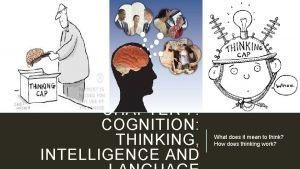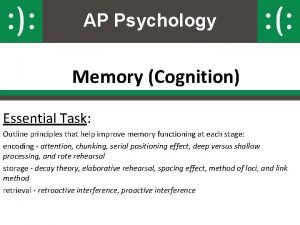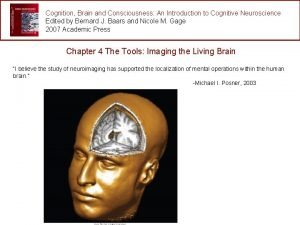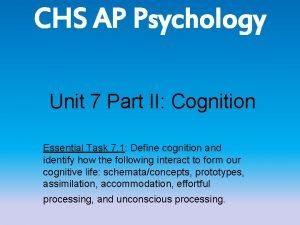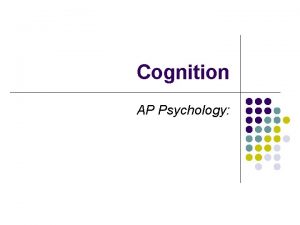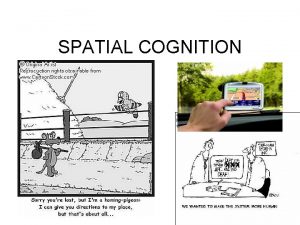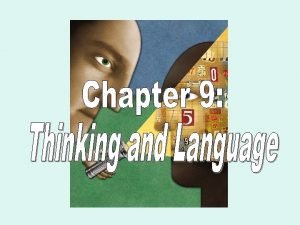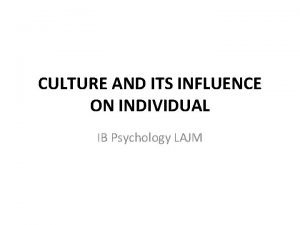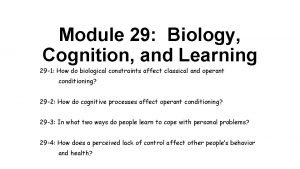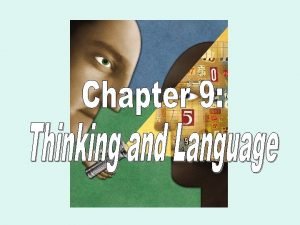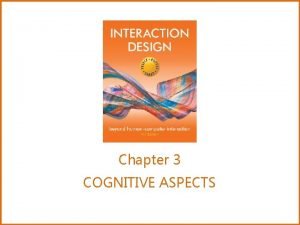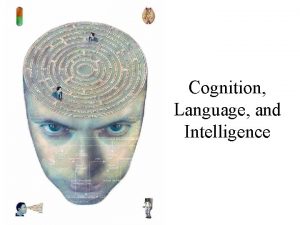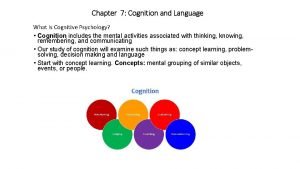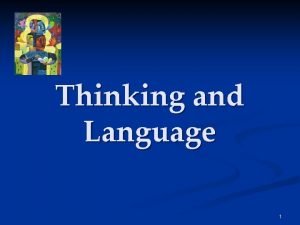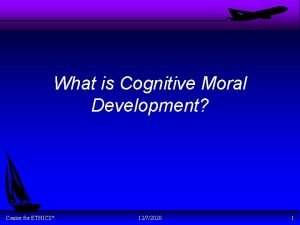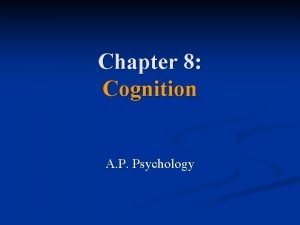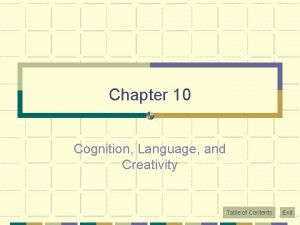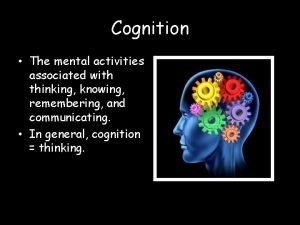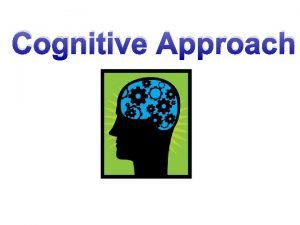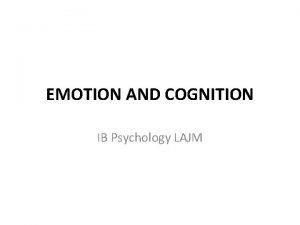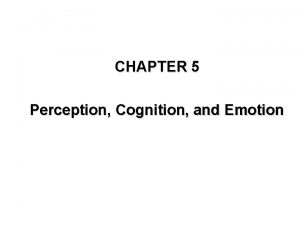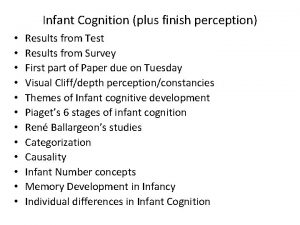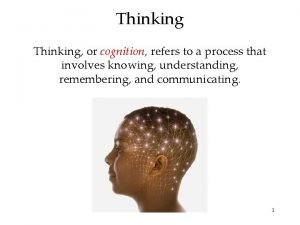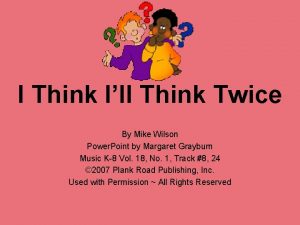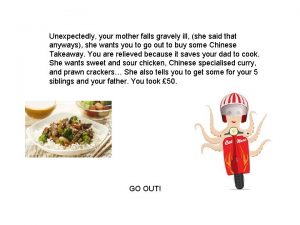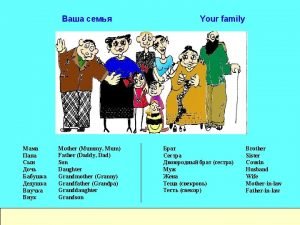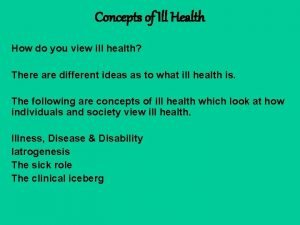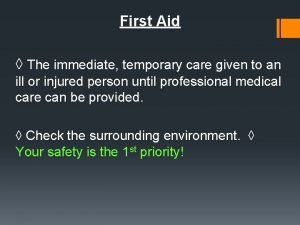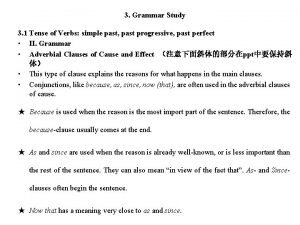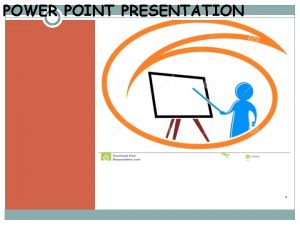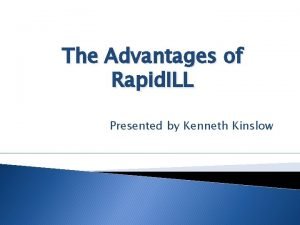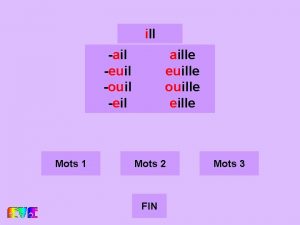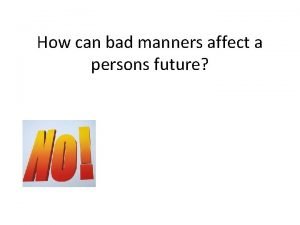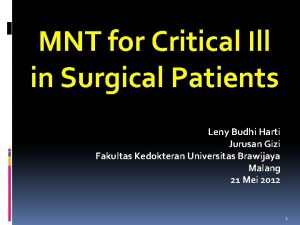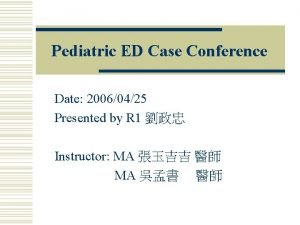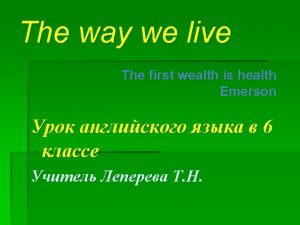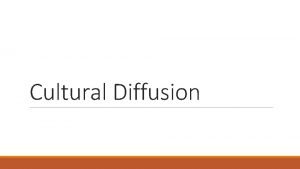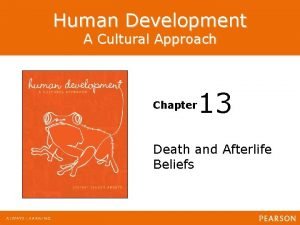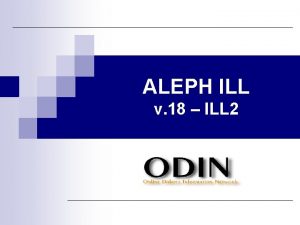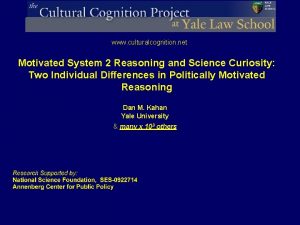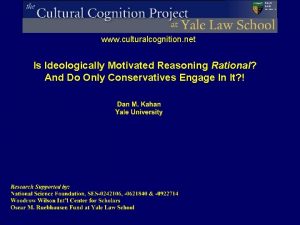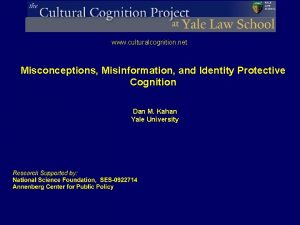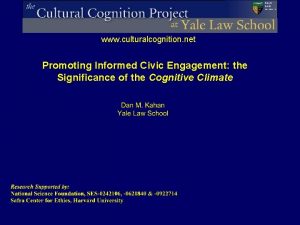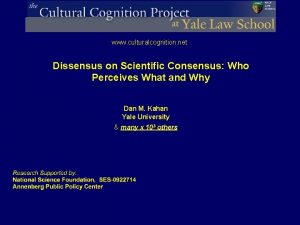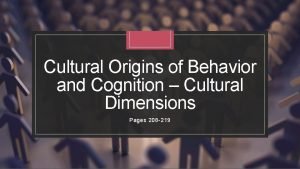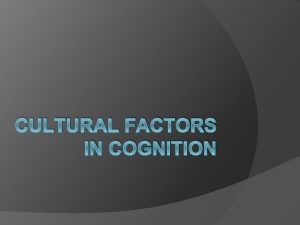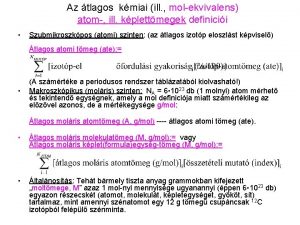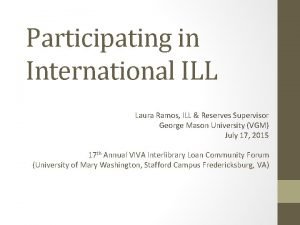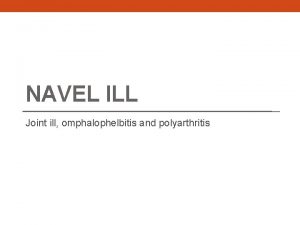www culturalcognition net What Is Cultural Cognition Ill



































































- Slides: 67

www. culturalcognition. net What Is “Cultural Cognition”? I’ll Show You!

Four Studies. . 1. “They Saw a Protest” 2. Scientific consensus 3. Science literacy & climate change polarization 4. "Politically motivated" numeracy


Did protestors cross the line between “speech” and “intimidation”?

Experimental Conditions Abortion Clinic Condition Recruitment Center Condition

Experimental Conditions Abortion Clinic Condition Recruitment Center Condition

Select fact perception items Case-outcome items

Cultural Cognition Worldviews Hierarchy hierarchical individualists hierarchical communitarians Individualism Communitarianism egalitarian individualists egalitarian communitarians Egalitarianism

Hypotheses Prodemonstrator Antidemonstrator “Complete Polarization” “Semi-polarization”

Pct. Agree Sample-wide Responses

Pct. Agree Abortion Clinic Recruitment Ctr

Pct. Agree Abortion Clinic Recruitment Ctr

Pct. Agree Abortion Clinic Recruitment Ctr

Pct. Agree Abortion Clinic Recruitment Ctr

Pct. Agree Abortion Clinic Recruitment Ctr

Pct. Agree Abortion Clinic Recruitment Ctr

Pct. Agree Abortion Clinic Recruitment Ctr

Hypotheses Prodemonstrator Antidemonstrator “Complete Polarization” “Semi-polarization”

Pct. Agree Protestors blocked Screamed in face Pedestrians just not want to Police just annoyed

N = 196. Dependent variable is pro_protestor (z-score). Bold denotes significant at p < 0. 05 pro_protestor (z-score) Prodemonstrator Antidemonstrator

Four Studies. . 1. “They Saw a Protest” 2. Scientific consensus 3. Science literacy & climate change polarization 4. "Politically motivated" numeracy

Four Studies. . 1. “They Saw a Protest” 2. Scientific consensus 3. Science literacy & climate change polarization 4. "Politically motivated" numeracy


Source: Kahan, D. M. , Jenkins-Smith, H. & Braman, D. Cultural Cognition of Scientific Consensus. J. Risk Res. 14, 147 -74 (2011).

Cultural Cognition Worldviews Risk Perception Key Low Risk High Risk Hierarchy Environment: climate, nuclear hierarchical individualists Guns/Gun Control Gays military/gay parenting hierarchical communitarians Abortion procedure cats/annoying varmints HPV Vaccination Individualism Communitarianism Gays military/gay parenting Abortion procedure egalitarian individualists cats/annoying varmints Environment: climate, nuclear Guns/Gun Control egalitarian communitarians HPV Vaccination Egalitarianism

Cultural Cognition Worldviews Risk Perception Key Low Risk High Risk Hierarchy Environment: climate, nuclear Guns/Gun Control Individualism Communitarianism Environment: climate, nuclear Guns/Gun Control Egalitarianism

Source: Kahan, D. M. , Jenkins-Smith, H. & Braman, D. Cultural Cognition of Scientific Consensus. J. Risk Res. 14, 147 -74 (2011).

Climate Change High Risk (science conclusive) Low Risk (science inconclusive)

Geologic Isolation of Nuclear Wastes High Risk (not safe) Low Risk (safe)

Concealed Carry Laws High Risk (Increase crime) Low Risk (Decrease Crime)

Featured scientist is a knowledgeable and credible expert on. . . Egalitarian Communitarian More Likely to Agree Hierarchical Individualist More Likely to Agree Pct. Point Difference in Likelihood of Selecting Response 60% 40% Climate Change 20% 0 20% 40% 60% 54% 72% 22% Nuclear Power 31% 58% Concealed Carry 61% N = 1, 500. Derived from ordered-logit regression analysis, controlling for demographic and political affiliation/ideology variables. Culture variables set 1 SD from mean on culture scales. CIs reflect 0. 95 level of confidence

Source: Kahan, D. M. , Jenkins-Smith, H. & Braman, D. Cultural Cognition of Scientific Consensus. J. Risk Res. 14, 147 -74 (2011).

Cultural Cognition Worldviews Risk Perception Key Low Risk High Risk Hierarchy Climate change Nuclear waste disposal Concealed carry bans Individualism Communitarianism Climate change Nuclear waste disposal Concealed carry bans Egalitarianism

Cultural Cognition Worldviews Perceived Scientific Consensus: Low Risk High Risk Hierarchy Climate change Nuclear waste disposal Concealed carry bans Individualism Communitarianism Climate change Nuclear waste disposal Concealed carry bans Egalitarianism

Four Studies. . 1. “They Saw a Protest” 2. Scientific consensus 3. Science literacy & climate change polarization 4. "Politically motivated" numeracy

Four Studies. . 1. “They Saw a Protest” 2. Scientific consensus 3. Science literacy & climate change polarization 4. "Politically motivated" numeracy

Four Studies. . 1. “They Saw a Protest” 2. Scientific consensus 3. Science literacy & climate change polarization 4. "Politically motivated" numeracy


The “Public Irrationality Thesis” 1. Science illiteracy 2. “Bounded rationality” 1+2+3= The “public irrationality thesis” (PIT)

“How much risk do you believe climate change poses to human health, safety, or prosperity? ” perceived risk (z-score) Greater Lesser U. S. general population survey, N = 1, 500. Scale 0 (“no risk at all”) to 10 (“extreme risk”), M = 5. 7, SD = 3. 4. CIs reflect 0. 95 level of confidence. source: Kahan, D. M. , Peters, E. , Wittlin, M. , Slovic, P. , Ouellette, L. L. , Braman, D. & Mandel, G. The polarizing impact of science literacy and numeracy on perceived climate change risks. Nature Clim. Change, 2, 732 -35 (2012).

“How much risk do you believe climate change poses to human health, safety, or prosperity? ” PIT prediction: Science Illiteracy & Bounded Rationality Greater perceived risk (z-score) High Sci. litearcy/System 2 (“slow”) Low Sci. litearcy/System 1 (“fast”) Lesser U. S. general population survey, N = 1, 500. Scale 0 (“no risk at all”) to 10 (“extreme risk”), M = 5. 7, SD = 3. 4. CIs reflect 0. 95 level of confidence. source: Kahan, D. M. , Peters, E. , Wittlin, M. , Slovic, P. , Ouellette, L. L. , Braman, D. & Mandel, G. The polarizing impact of science literacy and numeracy on perceived climate change risks. Nature Clim. Change, 2, 732 -35 (2012).

“How much risk do you believe climate change poses to human health, safety, or prosperity? ” perceived risk (z-score) Greater Risk Lesser Risk PIT prediction actual variance low high Science literacy actual variance low high Numeracy U. S. general population survey, N = 1, 500. Scale 0 (“no risk at all”) to 10 (“extreme risk”), M = 5. 7, SD = 3. 4. CIs reflect 0. 95 level of confidence. source: Kahan, D. M. , Peters, E. , Wittlin, M. , Slovic, P. , Ouellette, L. L. , Braman, D. & Mandel, G. The polarizing impact of science literacy and numeracy on perceived climate change risks. Nature Clim. Change, 2, 732 -35 (2012).

“How much risk do you believe climate change poses to human health, safety, or prosperity? ” Cultural variance conditional Cultural Variance on sci. literacy/numeracy? perceived risk (z-score) Greater Lesser Egalitarian Communitarian Low Sci lit/numeracy High Sci lit/numeracy Hierarchical Individualist U. S. general population survey, N = 1, 500. Scale 0 (“no risk at all”) to 10 (“extreme risk”), M = 5. 7, SD = 3. 4. CIs reflect 0. 95 level of confidence. source: Kahan, D. M. , Peters, E. , Wittlin, M. , Slovic, P. , Ouellette, L. L. , Braman, D. & Mandel, G. The polarizing impact of science literacy and numeracy on perceived climate change risks. Nature Clim. Change, advance online publication (2012), doi: 10. 1038/nclimate 1547.

“How much risk do you believe climate change poses to human health, safety, or prosperity? ” PIT prediction: Culture as heuristic substitute perceived risk (z-score) Greater Lesser Egalitarian Communitarian Low Sci lit/numeracy High Sci lit/numeracy Hierarchical Individualist U. S. general population survey, N = 1, 500. Scale 0 (“no risk at all”) to 10 (“extreme risk”), M = 5. 7, SD = 3. 4. CIs reflect 0. 95 level of confidence. source: Kahan, D. M. , Peters, E. , Wittlin, M. , Slovic, P. , Ouellette, L. L. , Braman, D. & Mandel, G. The polarizing impact of science literacy and numeracy on perceived climate change risks. Nature Clim. Change, advance online publication (2012), doi: 10. 1038/nclimate 1547.

“How much risk do you believe climate change poses to human health, safety, or prosperity? ” Actual interaction of culture & sci-lit/num. . . perceived risk (z-score) Greater High Sci lit/numeracy Egal Comm Low Sci/lit numeracy Egal Comm Low Sci lit/numeracy Low Sci lit/num. Hierarc Individ High Sci lit/numeracy Hierarch Individ Lesser U. S. general population survey, N = 1, 500. Scale 0 (“no risk at all”) to 10 (“extreme risk”), M = 5. 7, SD = 3. 4. CIs reflect 0. 95 level of confidence. source: Kahan, D. M. , Peters, E. , Wittlin, M. , Slovic, P. , Ouellette, L. L. , Braman, D. & Mandel, G. The polarizing impact of science literacy and numeracy on perceived climate change risks. Nature Clim. Change, advance online publication (2012), doi: 10. 1038/nclimate 1547.

“How much risk do you believe climate change poses to human health, safety, or prosperity? ” Actual interaction of culture & sci-lit/num. . . perceived risk (z-score) Greater High Sci lit/numeracy Egal Comm Low Sci/lit numeracy Egal Comm Low Sci lit/numeracy Low Sci lit/num. Hierarc Individ High Sci lit/numeracy Hierarch Individ Lesser U. S. general population survey, N = 1, 500. Scale 0 (“no risk at all”) to 10 (“extreme risk”), M = 5. 7, SD = 3. 4. CIs reflect 0. 95 level of confidence. source: Kahan, D. M. , Peters, E. , Wittlin, M. , Slovic, P. , Ouellette, L. L. , Braman, D. & Mandel, G. The polarizing impact of science literacy and numeracy on perceived climate change risks. Nature Clim. Change, advance online publication (2012), doi: 10. 1038/nclimate 1547.

“How much risk do you believe climate change poses to human health, safety, or prosperity? ” POLARIZATION INCREASES as scil-lit/numeracy increases perceived risk (z-score) Greater High Sci lit/numeracy Egal Comm Low Sci/lit numeracy Egal Comm Low Sci lit/numeracy Low Sci lit/num. Hierarc Individ High Sci lit/numeracy Hierarch Individ Lesser U. S. general population survey, N = 1, 500. Scale 0 (“no risk at all”) to 10 (“extreme risk”), M = 5. 7, SD = 3. 4. CIs reflect 0. 95 level of confidence. source: Kahan, D. M. , Peters, E. , Wittlin, M. , Slovic, P. , Ouellette, L. L. , Braman, D. & Mandel, G. The polarizing impact of science literacy and numeracy on perceived climate change risks. Nature Clim. Change, advance online publication (2012), doi: 10. 1038/nclimate 1547.

Four Studies. . 1. “They Saw a Protest” 2. Scientific consensus 3. Science literacy & climate change polarization 4. "Politically motivated" numeracy


“Skin cream experiment”

“Skin cream experiment”

Two conditions

Correct interpretation of data correct rash decreases rash increases incorrect Numeracy score Lowess smoother superimposed on raw data.

Numeracy numeracy score at & above which subjects can be expected to correctly interpret data.

“Gun ban experiment”

Four conditions

Correct interpretation of data skin treatment Numeracy score Gun ban

Correct interpretation of data skin treatment Numeracy score Gun ban Numeracy score

Correct interpretation of data Liberal Democrats (< 0 on Conservrepub) Conserv Republicans (> 0 on Conservrepub) skin treatment Numeracy score Gun ban Numeracy score

Correct interpretation of data Liberal Democrats (< 0 on Conservrepub) Conserv Republicans (> 0 on Conservrepub) skin treatment Numeracy score Gun ban Numeracy score

Best fitting regression model for experiment results rash_decrease rash increase crime increase z_numeracy_x_rash_decrease z_numeracy_x_rash_increase z_numeracy_x_crime_increase z_numeracy 2_x_rash_decrease z_numeracy 2_x_rash_increase z_numeracy 2_x_crime_increase Conserv_Repub_x_rash_decrease Conserv_Repub_x_rash_increase Conserv_Repub_x_crime_increase z_numeracy_x_Conserv_repub z_nuneracy_x_Conserv_Repub_x_rash_decrease z_nuneracy_x__x_rash_increase z_nuneracy_x__x_crime_increase _constant 0. 40 0. 06 1. 07 -0. 01 0. 55 0. 23 0. 46 0. 31 0. 02 -0. 07 -0. 31 -0. 64 0. 56 1. 28 0. 63 -0. 33 0. 54 0. 26 -0. 96 (1. 57) (0. 22) (4. 02) (-0. 05) (2. 29) (1. 05) (2. 01) (2. 46) (0. 14) (-0. 39) (-1. 75) (-3. 95) (2. 64) (6. 02) (2. 82) (-1. 89) (1. 40) (2. 17) (1. 08) (-4. 70) N = 1111. Outcome variable is “Correct” (0 = incorrect interpretation of data, 1 = correct interpretation). Predictor estimates are logit coefficients with z-test statistic indicated parenthetically. Experimental assignment predictors— rash_decrease, rash_increase, and crime_increase—are dummy variables (0 = unassigned, 1 = assigned—with assignment to “crime decreases” as the comparison condition. Z_numeracy and Conserv_Repub are centered at 0 for ease of interpretation. Bolded typeface indicates predictor coefficient is significant at p < 0. 05.

Liberal Democrat (-1 SD on Conservrepub) Conserv Republican (+1 SD on Conservrepub) Low numeracy rash increases high numeracy = 7 correct low numeracy = 3 correct High numeracy rash decreases rash increases rash decreases skin treatment rash increases probabilility of correct interpretation of data crime decreases crime increases crime decreases crime increases Gun ban 0% probabilility of correct interpretation of data 10% 20% 30% 40% 50% 60% 70% 80% 90% 100% probabilility of correct interpretation of data

Liberal Democrat (-1 SD on Conservrepub) Conserv Republican (+1 SD on Conservrepub) Low numeracy high numeracy = 7 correct low numeracy = 3 correct High numeracy Avg. “polarization” on crime data for low numeracy partisans 25% (± 9%) Avg. “polarization” on crime data for high numeracy partisans 46% (± 17%) crime decreases crime increases crime decreases crime increases Gun ban 0% probabilility of correct interpretation of data 10% 20% 30% 40% 50% 60% 70% 80% 90% 100% probabilility of correct interpretation of data

Egalitarian communitarian (-1 SD on Hfac & Ifac) Hierarch individid (+1 SD on Hfac & Ifac) Low numeracy high numeracy = 7 correct low numeracy = 3 correct High numeracy EC rash increases HI rash decreases skin treatment EC rash increases EC rash decreases HI rash decreases EC rash decreases HI crime decrease HI crime increase EC crime increase HI crime increase EC crime decrease Gun ban HI crime decrease probabilility of correct interpretation of data EC crime increase probabilility of correct interpretation of data

“How much risk do you believe climate change poses to human health, safety, or prosperity? ” POLARIZATION INCREASES as scil-lit/numeracy increases perceived risk (z-score) Greater High Sci lit/numeracy Egal Comm Low Sci/lit numeracy Egal Comm Low Sci lit/numeracy Low Sci lit/num. Hierarc Individ High Sci lit/numeracy Hierarch Individ Lesser U. S. general population survey, N = 1, 500. Scale 0 (“no risk at all”) to 10 (“extreme risk”), M = 5. 7, SD = 3. 4. CIs reflect 0. 95 level of confidence. source: Kahan, D. M. , Peters, E. , Wittlin, M. , Slovic, P. , Ouellette, L. L. , Braman, D. & Mandel, G. The polarizing impact of science literacy and numeracy on perceived climate change risks. Nature Clim. Change, advance online publication (2012), doi: 10. 1038/nclimate 1547.

Four Studies. . 1. “They Saw a Protest” 2. Scientific consensus 3. Science literacy & climate change polarization 4. "Politically motivated" numeracy

What is cultural cognition? Why should we care? 1. What explains the science communication problem? 2. How can we fix it? So what should we do?
 Cognition thinking intelligence and language
Cognition thinking intelligence and language Serial 7s
Serial 7s Embodied cognition ap psychology
Embodied cognition ap psychology Consciousness
Consciousness Embodied cognition ap psychology
Embodied cognition ap psychology Chomsky ap psychology
Chomsky ap psychology Hippocampus taxi drivers
Hippocampus taxi drivers Altered cognition in older adults is commonly attributed to
Altered cognition in older adults is commonly attributed to Cognition refers to
Cognition refers to Acculturation ib psychology
Acculturation ib psychology Module 29 biology cognition and learning
Module 29 biology cognition and learning Psychology unit 7
Psychology unit 7 Cognition and personalization
Cognition and personalization Chapter 7 cognition thinking intelligence and language
Chapter 7 cognition thinking intelligence and language Cognition refers to
Cognition refers to Embodied cognition ap psychology
Embodied cognition ap psychology What is cognition
What is cognition Iq of blacks
Iq of blacks What is cognition
What is cognition Jalan pintas mental
Jalan pintas mental What is cognition
What is cognition Linguistic determinism
Linguistic determinism Moral cognition
Moral cognition Mental status examination example
Mental status examination example Embodied cognition ap psychology
Embodied cognition ap psychology Cognition definition
Cognition definition The mental activities associated with thinking
The mental activities associated with thinking Cognition definition
Cognition definition Teacup ib psychology
Teacup ib psychology Types perception
Types perception Cognition plus
Cognition plus Cognitive dissonance definition
Cognitive dissonance definition Ill think
Ill think Scream and ill tell your mom
Scream and ill tell your mom Where you go i'll go where you stay i'll stay
Where you go i'll go where you stay i'll stay If you were grammar
If you were grammar Doth meaning
Doth meaning Slidetodoc.com
Slidetodoc.com Tell me and ill forget
Tell me and ill forget Care of the critically ill surgical patient
Care of the critically ill surgical patient Talk about what you did last weekend
Talk about what you did last weekend Feigned insanity forensic
Feigned insanity forensic Concepts of ill health
Concepts of ill health Verb to noun suffix
Verb to noun suffix First aid
First aid Fabiana will not go to work today __ a bit ill
Fabiana will not go to work today __ a bit ill Ill project management
Ill project management It was such a foggy day that we couldn't see the road
It was such a foggy day that we couldn't see the road The snow hath retreated meaning
The snow hath retreated meaning Rapid ill
Rapid ill Song ill be waiting
Song ill be waiting C ill
C ill Yesterday you met a friend of yours charlie
Yesterday you met a friend of yours charlie Stalling objection
Stalling objection Ill kill him
Ill kill him Manners definition
Manners definition Mnt critically ill
Mnt critically ill Ticls
Ticls Ill methodology workshop
Ill methodology workshop Rising action of the sob sisters story
Rising action of the sob sisters story Doing nothing is doing ill
Doing nothing is doing ill Ado.net vb.net
Ado.net vb.net Achmed lach net ich krieg mein tach net
Achmed lach net ich krieg mein tach net Cultural revolution
Cultural revolution Arjun appadurai mediascape
Arjun appadurai mediascape Define cultural diffusion
Define cultural diffusion Human development a cultural approach
Human development a cultural approach Cultural trait definition
Cultural trait definition
